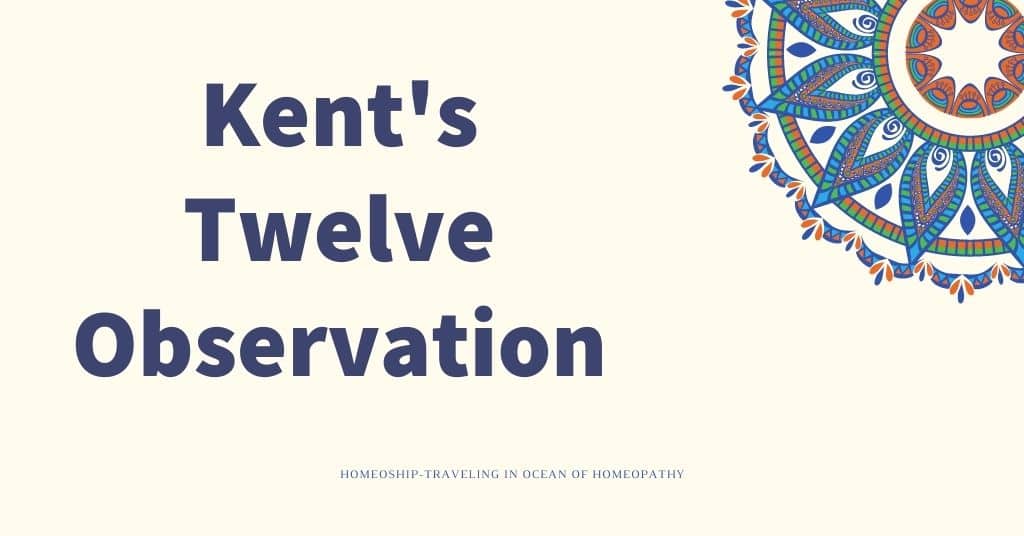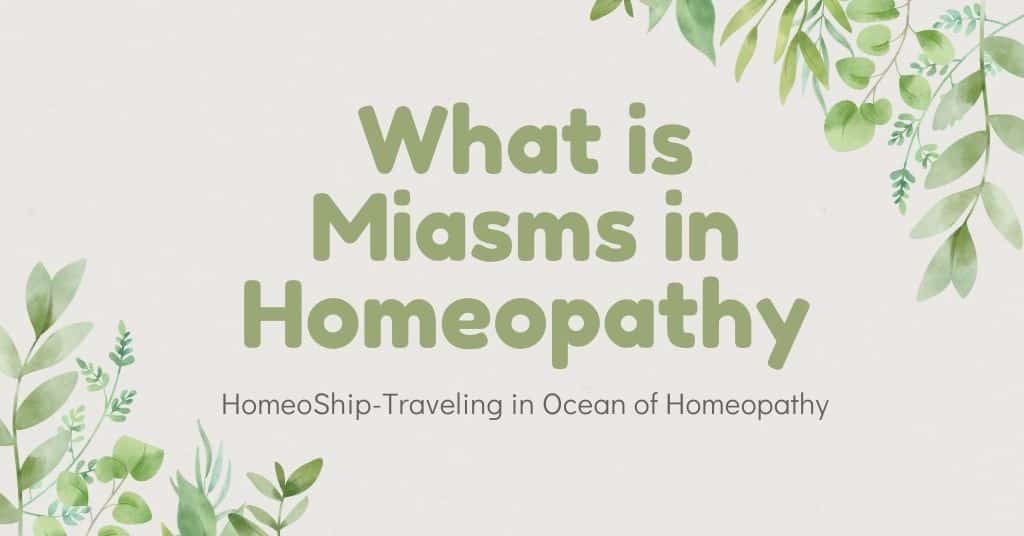Contents
- First Observation: A Prolonged Aggravation and Final Decline of the Patient
- Second Observation: Long Aggravation with Final Slow Improvement
- Third Observation: Aggravation is Quick, Short, and Strong with Rapid Improvement of the Patient
- Fourth Observation: No Aggravation with Recovery of the Patient
- Fifth Observation: Amelioration Comes First and Aggravation Comes Afterwards
- Sixth Observation: Too Short Relief of Symptoms
- Seventh Observation: A Full-Time Amelioration of Symptoms Yet no Special Relief to the Patient
- 8. Eighth Observation: Some Patients Prove Every Remedy They Get
- Ninth Observation: Action of the Medicine Upon Provers
- Tenth Observation: New Symptoms Appearing After the Remedy
- Eleventh Observation: When Old Symptoms are Observed to Reappear
- Twelfth Observation: Symptoms Take the Wrong Direction
Hello Homeopaths, today we going to under the basic details regarding the popular concept known as Dr Kent’s Twelve Observations on Remedy or Remedy Relationship. The topic “ Kent’s Twelve Observations ” is originally compiled from “lecture no XXXV: Prognosis after observing the action of the remedy” from the book Kent’s “Lectures on Homoeopathic Philosophy”.
The mission of the physician does not stop with the prescription of the remedy itself. Especially in chronic cases, he has to make some observations to know, whether the remedy is bringing out any curative reaction or not. How the remedy is acting and what has to be done next? The second prescription and the consecutive prescriptions depend upon these observations only.
The following observations of Kent have grown out of much watch fullness, long waiting, and watching. “If the homoeopathic physician is not an accurate observer, his observations will be indefinite, and if his observations are indefinite, his prescription is indefinite”.

Symptoms always guide the physician in making observations. After administering suitable remedies the change of symptoms, the disappearance of symptoms, aggravation of symptoms, and amelioration of symptoms are to be studied. After administering a similimum, Kent explains that any one of the following 12 possibilities can be noticed in the patient and which are popularly known as Kent’s Twelve Observations.
First Observation: A Prolonged Aggravation and Final Decline of the Patient
After the first prescription, if this observation is found, the physician has to interpret that the case was an incurable one. We have handled a case with an unfavourable prognosis. It is also known as Killer’s Aggravation. Pathological destruction may have already taken place in this case. We have handled a case where the reaction of the vital force is almost impossible or useless. The prescribed anti-psoric remedy was a deep-acting one for the case.
Steps to be taken: Antidote the remedy immediately. The case is an incurable one, so the prognosis will be bad if no antidote.
Lesson to learn: In incurable and doubtful cases do not use higher potencies, use the remedies with care, and never above 30th or 200th. In such cases, always start the remedies in 30th potencies, and never repeat the doses frequently. In cases with organic damage or pathologically advanced cases deep acting, curative remedies should not be given. Always start the treatment with low potency.
Second Observation: Long Aggravation with Final Slow Improvement
This observation indicates that the disease is still in a curable state. The organic or pathological changes are not so advanced. The tissue change is in the beginning stage. The vital force is still in the form of the reactive stage; hence the aggravation has lasted for a long time, followed by final slow improvement. We have given the curative remedy at the right time if the remedy had been given a little time later the case would have advanced further and a cure would have been impossible.
Steps to be taken: The case is curable. The prognosis is good, do not repeat any remedy, and wait and watch for the reaction.
Lessons to learn: It is always better to start any medicine in low potencies. In doubtful cases antidote has to be kept ready to meet any type of untoward incidences like severe aggravations or if symptoms take the wrong course.
Third Observation: Aggravation is Quick, Short, and Strong with Rapid Improvement of the Patient
This is the classical homoeopathic aggravation. It is the most favourable condition any homoeopath would like to observe. The selected remedy is the correct one. The improvement of the patient will be long-lasting. There are no structural or tissue changes in the patient. The prognosis of the case will be very good.
Steps to be taken: The case is in good condition, wait and watch. Stop any repetition of the remedy.
Lessons to learn: Quick, short, and strong aggravation is the one that can bring a long-lasting improvement in the patient. In acute cases, the third observation of Kent is seen a few hours after administering the remedy, in chronic cases, it is seen a few days after administering the remedy.
Fourth Observation: No Aggravation with Recovery of the Patient
It is the classical homoeopathic cure. The selected remedy, its potency, and the dose are exactly suitable to the case. There is no pathological change in the patient. The disease is at its functional level and belongs to the nerves and their functions. If the fourth observation is noticed in acute diseases, it is very good and cures the case rapidly and gently. But if the fourth observation is noticed in chronic cases, it leaves the physician in doubt. In such conditions, it is difficult to judge whether the remedy acted curatively or plaintively.
Steps to be taken: In both acute and chronic cases if the fourth observation is noticed, any repetition of the remedy has to be stopped. In acute cases, it proves to be curative. In chronic diseases it is difficult to judge; hence any repetition of the dose has to be stopped because this may interrupt the action of the curative remedy that has been given. The case has to be kept under observation.
Lessons to learn: It is the highest order of cure, especially in acute conditions. Yet the physician wishes to notice a slight homoeopathic aggravation at the beginning of the cure.

Fifth Observation: Amelioration Comes First and Aggravation Comes Afterwards
This condition is unfavourable. The remedy prescribed has either acted superficially or in a palliative manner. Also happens in some cases where the patient was in an incurable case and he was administered a partially suitable remedy based on the most annoying symptoms alone.
Steps to be taken: Re-examine the symptomatology and find out whether the selected remedy was chosen based on the totality of symptoms? Whether the remedy is covering the characteristic totality of the case? Whether the patient is in a curable state or we are handling an incurable case? Whether the selected remedy is the constitutional, deep-acting one or the acute superficially-acting remedy?
Lessons to learn: In a long seated and severe case, if amelioration comes first the physician has to suspect the case and re-examine it again. He tries to find out the fault at the remedial level, patient level, and the repetition of the remedy, etc.
Sixth Observation: Too Short Relief of Symptoms
The higher potencies act for a long time. The curative remedy relieves the patient for a long time. In some cases, initially, the patient reports that he has been doing well and improving, but after a long gap he may complain, “I have been running down”. Then the condition requires the following investigations:
Steps to be taken: There may be some obstacles to cure. The patient may have done something to interrupt the action of the remedy. Habits like drinking alcohol, smoking, and handling some chemicals like ammonia, etc, may interfere with and spoil the curative action of the remedy.
If such obstacles are not present in acute cases, the sixth observation indicates high-grade inflammatory conditions which may interfere with the prognosis and the improvement of the case. In chronic cases, the sixth observation indicates that the case is pathologically advanced or that structural changes have taken place in the patient already. Hence the prognosis is bad.
Lessons to learn: We have to suspect the amelioration that always comes very early. The best amelioration will always come gradually, at the end of an hour or two hours that is likely to remain.
Seventh Observation: A Full-Time Amelioration of Symptoms Yet no Special Relief to the Patient
In the latent conditions and the latent organic conditions, we observe this seventh observation. The patient in such conditions does not improve above this state. For example, a patient with one kidney can improve to a certain degree only as his organic development is such. A patient with fibrinous structural changes in certain places like tubercles that have been encysted and lungs capable of doing only limited work will have limited symptoms. These symptoms will be ameliorated from time to time with remedies, but the patient is only curable to a certain extent. He cannot go beyond and rise above such a state.
Steps to be taken: The case is only suitable for homoeopathic palliation and the prognosis with these palliative remedies will be good. But the patient is not cured and is never cured.
Lessons to learn: In some latent organic conditions, the cure is not possible and palliation is the only solution. We cannot expect the highest ideal of cure in almost every case we handle.
Also Read: What is Happy Go Lucky Operation in Homeopathy?
8. Eighth Observation: Some Patients Prove Every Remedy They Get
If such a condition is observed, we have to think that a patient is an idiosyncratic person. These patients are known to be hysterical, overwrought, and oversensitive to many things. After receiving high potency, they go on to prove this medicine. When they are under the influence of this medicine they cannot come under the influence of any other medicine. Such patients are great provers; they will prove to have higher potencies of medicines. After they get out of one proving, they are quite ready to repeat it or go into another.
Steps to be taken: These over-sensitive patients are sometimes incurable. These types of cases will have bad prognoses. When you find a case that proves everything that you give in higher potencies, go back to the 30th potency and the 200th potency. We can cure their acute conditions by giving them 30th and 200th potencies and their chronic conditions by giving them 30th, 200th and 500th potencies.
Lessons to learn: It is difficult to cure the so-called oversensitive patients, who are known to have idiosyncrasies about everything. Many of them are born with this sensitivity and they will die with it. They are not capable of rising above this over-irritability and over-wrought state.

Ninth Observation: Action of the Medicine Upon Provers
Healthy provers are always benefited by proving if they are properly conducted. The constitutional symptoms of the prover have to be carefully noted down and subtracted from the symptoms of the drug. These symptoms will not very commonly appear during the proving; if they do, note the change in them.
Tenth Observation: New Symptoms Appearing After the Remedy
If an array of new symptoms appear after administration of the remedy, the prescription has to be suspected. The prescription is not the right one. The condition will be unfavourable.
Steps to be taken: Before coming to any conclusion, the new symptoms have to be verified by the physician with the help of the patient and his attendants. In some instances, the new symptoms turn out to be old symptoms that the patient may have forgotten to mention during case-taking, considering them to be unimportant. Or else the patient may have not noticed, or forgotten these new symptoms, as they have occurred in his tender life, only his parents may recall them. If these symptoms were never observed by anybody before, the appearance of new symptoms is an unfavourable condition. The remedy has to be antidoted or changed.
Lesson to learn: This condition is an unfavourable one. The probability is that after these new symptoms have passed away, the patient may settle into the original state. These new symptoms are the symptoms of the medicine and the patient is not going to recover with this remedy. To avoid such a state, the first prescription has to be made carefully based on the entire totality of symptoms.
Eleventh Observation: When Old Symptoms are Observed to Reappear
The condition is much more favourable. The disease is a curable one. If the symptoms follow the reverse order of appearance of symptoms and follow Hering’s law of cure, the cure is inevitable. The patient is on the road to recovery.
Steps to be taken: Remedy has to be left to complete its action. Further repetition of the dose is not advisable at this stage, as it may interrupt the action of the remedy. If the old symptoms come back to stay, a repetition of the dose is often necessary. The patient must be encouraged that he is on the road to recovery.
Lessons to learn: The appearance of old symptoms after prescribing a remedy is a good indication in any case. If the symptoms are appearing according to Hering’s law of cure, it is going to bring a classical cure. The cure must take place from above downwards, within outwards, from more important organs to less important organs and in the reverse order of appearance of the symptoms. It is the most favourable condition.
Also Read: What is Simple Substance in Homeopathy?
Twelfth Observation: Symptoms Take the Wrong Direction
It is a poor prognostic condition. The symptoms do not follow Hering’s law of cure. The administered medicine is not the perfect similimum. The medicine was not selected properly by considering the general symptoms, but it was selected based on the particulars. The prognosis of the case would be bad, as the remedy is suppressing the disease manifestations.
Example: After a medicine is administered in a case of rheumatism, it produces instant relief to joint pains but at the cost of distress to internal organs like the heart and spine, etc. In such a condition, it indicates the transfer of symptoms from the periphery to the centre, i.e. it is not curing the condition instead, it is suppressing the case. It is an unfavourable condition.
Steps to be taken: Antidote the medicine immediately. Otherwise, structural changes would take place in the new site.
Lessons to learn: The remedy must always be selected based on the general symptoms of the case. Importance must always be given to the symptoms that are related to the patient as a whole. The curative process is always from the centre to the periphery and not from the periphery to the centre. If a reverse of Hering’s law is noticed after administering any remedy, the remedy has to be antidoted immediately.
Remedy reaction is an important subject to be understood by any homoeopath for the successful application of the law of similia. Many cases in homoeopathic practice are lost not because of poor selection of the remedy or potency, but on account of the failure to read correctly the language of signs and symptoms. Kent’s Twelve Observations helps aspiring physicians train themselves in such tasks.



